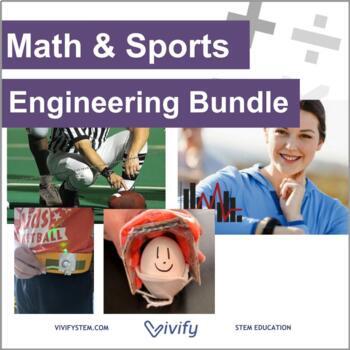Math, Sports & Engineering Activity Bundle: Ratios and Proportions
- Zip
What educators are saying
Products in this Bundle (5)
Also included in
- Are you in need of year-round STEM activities? This growing bundle includes ALL Vivify K-12 STEM lessons from team challenges, engineering design, semester-long STEM units, research projects, and more! Purchase everything for 20% off individual products! Here is a sample of what is included: Stage 1Price $990.24Original Price $1237.80Save $247.56
Description
Engaging activities connecting math concepts to sports along with an engineering design challenge! Instead of boring worksheets, students will solve problems based on their own collected data and connect the concepts to cool careers!
Students will be surprised to learn how much math is used in their favorite sports. Each activity will get your kids out of their seats and playing paper football, running a relay race, or measuring their heart rate! Each activity also includes a STEM (Science, Technology, Engineering, Math) career connection that will help students see why math is useful in real life.
Each activity will take about 45 - 60 minutes to complete depending on student level. The activities are perfect as an in-class assignment, review activity, homework assignment, or extracurricular activity. Activities are focused on ratios and proportions concepts. Each activity includes an introduction, career connection section, discussion questions, word problems, and extension critical thinking questions.
A capstone challenge includes an engineering design activity to protect an egg (representing a human brain) during impact by designing a helmet.
Activity 1: "Heart Rate Math"
Students learn about heart rate and the importance of this number in sports medicine. They compute their own heart rate after various activities and graph the results. They calculate the target heart rate and answer critical thinking questions.
Activity 2: "Sports Scores"
Students learn how their favorite sports calculate common statistics like batting average or throwing accuracy. Students then play a game of paper football to find their own field goal accuracy!
Activity 3: "Relay Race"
Students complete calculations for a set of relay race times then they hold their own race! Using common classroom items, they time the race and calculate various ratio problems such as "keeping the same pace, how long would it take to run 3 miles?"
Activity 4: Brain Safety Football Helmet Engineering Challenge: Students will learn about protecting our brains and then design and the evolution of the football helmet. Students are then tasked to use the engineering design process to design, build, and test a helmet to protect an egg (mimicking the brain) from a 1 foot drop.
Activity 5: Wearable Device Sports Engineering Activity: Whether football or swimming, athletes work hard to stay in shape and improve their performance. They often push their bodies to the limit, and they need ways to communicate to their coaches if they are in distress. For this challenge, your engineering company is tasked with designing a wearable device that allows athletes to communicate even during intense exercising.
Looking for more STEM lessons? Our team of engineers and educators is dedicated to developing low-prep and high-quality STEM activities for any classroom! Click below to learn more:
- Vivify's Scope & Sequence + Standards Alignment
- Vivify's Resource Guide
- Learn about the 3 Stages of STEM
- Vivify STEM Membership
Customer Tips:
• Click the Green ★ to follow our store and get notifications of new products and freebies
• Leave feedback to receive TpT credit for use on future purchases
• Questions? Contact us in the Product Q&A section
♥ Connect With Us ♥
Email us: info@vivifystem.com






